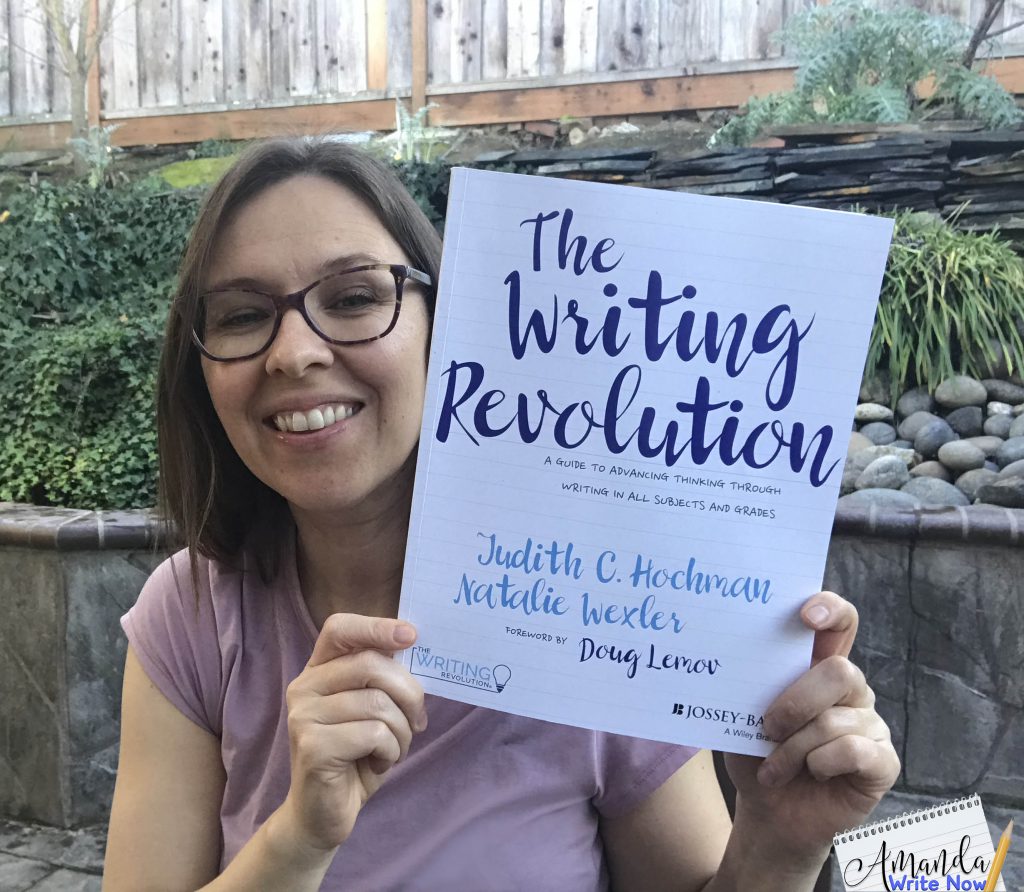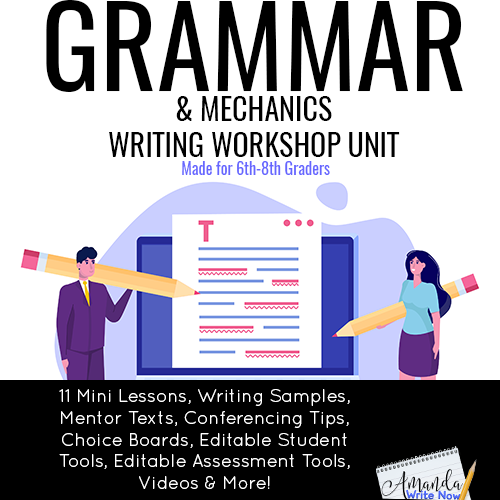
Have you ever felt you weren’t supporting a group of students with writing? Maybe these students had IEPs, maybe they didn’t, maybe they were the students who turned in writing that was all over the place, spelling mistakes, run-on sentences, no paragraphs…you know what I’m talking about. And you just didn’t know how to support these students or even where to start!?!
You are not alone. I’ve felt at a loss for how to support struggling writers every single year of my 13 years as a teacher.
There are so many varying levels within one classroom. It can be hard to wrap your mind around how to support students who are struggling with writing and seem far behind all the other writers in your classroom. However, there are things we can do, that all students can benefit from, both advanced writers and struggling writers.
According to Natalie Wexler, author of The Knowledge Gap and co-author of The Writing Revolution, students who struggle with writing, and all students for that matter, need explicit instruction at the sentence level. After reading Wexler’s books, I couldn’t agree more.
*All links to books in this blog post are Amazon Affiliate links. This means that if you purchase the book through my link, I’ll receive a commission. I only recommend books I love and have made a big impact on me!
Wexler also argues that we need to be providing students with much more knowledge about science, history, our world, current events and social issues and that we can teach writing through the lens of this information. So, I recommend you teach the mini lessons in this post within the context of whatever you are having students read. Sentence level instruction can be done within the context of what we are already doing in our classrooms.
All of the examples provided in the mini lessons are from a book called, The 57 Bus by Dashka Slater. This is an important book about a true event that occurred in Oakland in 2013. It is an important book because it challenges our students assumptions about gender, provides information about our juvenile justice system and exposes the enormous impact the media has on people and their beliefs about crimes, criminals and current events in general.
Now, here are those mini lessons…
Important Note: Judith C. Hochman and Natalie Wexler, authors of The Writing Revolution, explain that it is not necessary to teach formal definitions of grammar terms such as fragments, subjects, predicates, conjunctions etc. especially if students really struggle with reading and writing. Complex grammatical terms can just confuse students even more. However, they do say you can introduce these terms if you feel students are ready.

Mini Lesson 1: Sentence Fragments
Fragments are incomplete sentences but for this mini lesson you don’t need to explain that term yet.
First, start out by providing students with oral examples of fragments. Check out this slideshow providing fragment examples from The 57 Bus. Ask students what could be added to make the sentence complete.
After discussing what’s missing from the fragments provide oral examples of complete sentences. Ask students what they notice, how are the fragments and complete sentences different?
At the next level, begin giving students activities to complete that allow them to identify fragments and sentences. This slideshow provides an activity you might consider using or you can choose to use activities that relate to what your students are currently studying.
You might also introduce the terms subject and predicate at this point. Remember this can all be done within the context of the subject matter students are learning about. You could take sentences from the novel you are studying or a nonfiction article.
Teaching about fragments is an important building block for the next sentence level instruction you will be doing…
Mini Lesson 2: Conjunctions
Hochman and Wexler recommend teachers use the conjunctions, because, but, and so to begin teaching about independent and dependent clauses.
A clause is a complete sentence that contains a subject and a predicate. This is related to the fragments and complete sentences concepts from above because fragments are missing either a subject or predicate.
Here’s how it might work:
The teacher gives students a sentence stem that ends in one of the conjunctions and students have to complete the stem. Check out this slideshow to get a copy of the examples.
Again, it is not necessary to teach the grammatical terms when introducing these concepts. It’s preferable for the teacher to model using these terms to complete sentence stems and experience guided practices before bombarding students with the vocabulary associated with these ideas.
Here’s an example from The 57 Bus by Dashka Slater…
Oakland is considered one of the most diverse cities because…
Richard flicked a lighter but…
Sasha felt confused about their gender so…
After lots of modeling, guided practice with completing these sentence stems and using these conjunctions, you can introduce subordinating conjunctions that connect two ideas together such as although, before, even though and while. These words are particularly helpful when writing argumentatively. Hochman and Wexler again suggest providing students with sentence stems they can complete using these subordinating conjunctions.
Here’s another example from The 57 Bus by Dashka Slater….
Although Richard and Sasha lived in different neighborhoods they…
Before courts sentenced Richard…
Even though Sasha was badly hurt…
While Richard was awaiting trial he…
Spoiler Alert: If you’ve never read The 57 Bus you may want to skip the examples provided in mini lesson #3.
MIni Lesson 3: Appositives
In order for students to write more complex sentences they need to learn how they can use commas to add additional information in their sentences. One way to teach students how to write complex sentences is by showing students examples of appositives.
Appositives are nouns positioned next to another noun that add more detail to a sentence.
Here’s an example from The 57 Bus…
Richard, a 16 year old teen from Oakland, made a huge mistake that impacted the rest of his life.
Check out this slideshow to get a copy of more examples.
The appositive is “a 16 year old teen from Oakland”.
Appositives are nouns that follow the noun being described.
When teaching students about appositives, give example sentences containing appositives and show how the sentence can still be complete without the appositive.
Instead of teaching the term appositive, teach students that they can add details to describe the person, place or thing of the sentence.
Once students have been exposed to examples, Hochman and Wexler recommend providing students with activities where they have to match nouns with appositives. Here’s an example from The 57 Bus.
A 16 year old sophomore
An 18 year old senior
The most diverse city in the nation
Sasha,_____________________, attended MIT after graduating.
Richard,____________________, was tried as an adult sentenced to 7 years in state prison but eventually his time was reduced for good behavior.
Oakland,___________________, was where both Sasha and Richard grew up.
Mini Lesson 4: Sentence Combining
After building a foundational knowledge of fragments, conjunctions and appositives, next you’ll want to teach students how to combine sentences. Hochman and Wexler describe how this can be done in their book The Writing Revolution…
First, give students simple short sentences all related to the same topic you have been studying. Then, model ways in which these simple sentences can be combined. An example from The 57 Bus is provided below. After modeling, you’ll want to give students new sentences to try with your guidance and feedback.
Simple Sentences:
Oakland is rural.
Oakland is urban.
Oakland is diverse.
Ways to Combine:
Oakland is both rural and urban, it is also a diverse city.
Oakland is rural, urban, and diverse.
Oakland, a diverse city, is both rural and urban.
Mini Lesson 5: Expanding Sentences
Hochman and Wexler call very simple sentences such as, “Richard looked”, a “kernel sentence”. These sentences aren’t fragments, they are complete sentences, they are just super simple, only containing a subject and predicate.
In this mini lesson you’ll provide students with kernel sentences to expand with a chart that includes these questions:
Who?
What?
When?
Where?
Why?
How?
Students don’t have to answer all the questions to expand a sentence. You can have students expand the sentence by answering just two or three of the questions.
So, the kernel sentence “Richard looked” might become, “Richard looked at Sasha in the back of the bus, stunned at what he saw.” This expanded sentence answers the questions, where, who and how.
You’ll want to model multiple examples of expanding kernel sentences using these questions words before having students try it on their own. Use this slideshow to get examples from The 57 Bus to use with your students.
Next Steps…
Struggling writers need our help and support. The good news is that these lesson ideas can be extremely beneficial for all students, not just struggling writers. If you’d like access to a growing resource library of tools for struggling writers sign up for my email list below! I plan to add more mini lessons just like the ones in this slideshow. I also have an awesome writing workshop unit dedicated specifically to grammar and mechanics below. Click the image to view the video preview of this unit and learn more!


This fits what I have been thinking about as I start a new academic year with my class and know how some students don’t know how to expand the sentences they write to be more complex. Being the bare bones, means it is manageable to consider and to fit my class material. Providing the slide show is impressive. I have just been watching 4 teachers about how to conference a student as I feel like I keep missing something for some of my students when they leave and they are still relying on simple sentence structure.
Thanks for taking the time to leave a comment Jake! I really appreciate your perspective and ideas about using these mini lessons at the beginning of the school year as well as for conferring purposes.